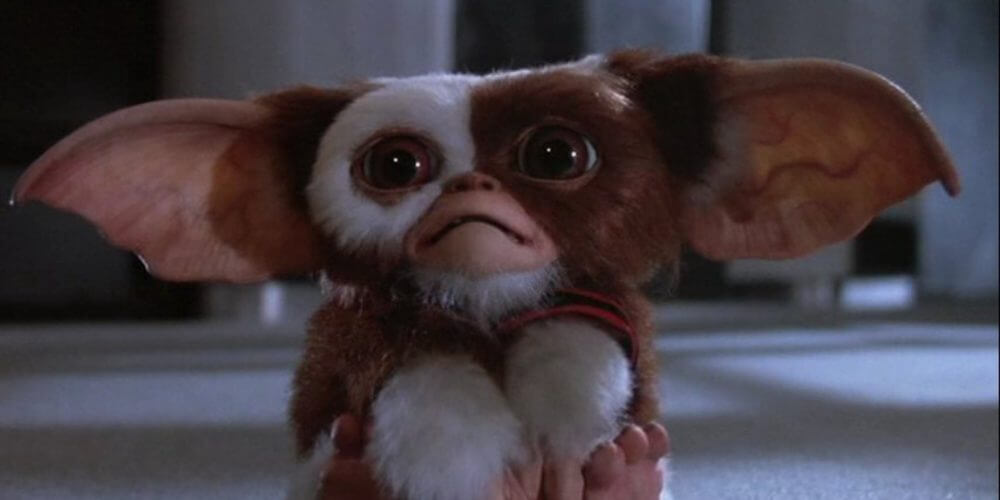
Consider the East Asian monsoon. This famous weather pattern, immortalized in the folklore and literature of the East, causes a cycle of heavy seasonal rains. The animal life of Southern and Eastern Asia have evolved to take advantage of the monsoon, and the area’s human inhabitants have incorporated it into their way of life.
Like so much else, however, the monsoons are being disrupted by climate change. In recent years, the monsoon season has grown shorter and shorter, with prolonged dry periods in between that more and more often cross over into drought. When the rains do come, they are shorter and more intense than before, causing catastrophic flash floods. This rapid change is devastating animal habitats and imperiling thousands of species across Asia.
A notable exception is the Mogwai: the semi-intelligent, asexually-reproducing Chinese primate familiar to Westerners from the 1984 movie Gremlins. The combination of torrential rains followed by long periods of drought is particularly conducive to the Mogwai’s breeding. The heavy rains cause the animals to reproduce uncontrollably – a single Mogwai swept up by a cresting river can blanket the river’s entire surface with offspring in a matter of hours. And unlike other animals, Mogwai have no need of water except to reproduce, perfectly poising them to survive long dry spells.
The resulting Mogwai population boom has left large swaths of the countryside infested with the crafty animals. Liu Dang, a farmer in Anhui province, lost everything to the Mogwai.
“They ate all my wheat – seed, stalk, everything.” Liu reports. “Then they jumped on all my chickens and goats. I saw one grab a chicken by the legs and push it into its mouth whole. It withdrew a bare skeleton, let out a long burp, and then sat down with a toothpick.”
Although many farms have seen similar attacks, the Mogwai seem most drawn to cities. They favor human snack foods, particularly after midnight, when they metamorphose into their reptilian “Gremlin” form after eating. China’s growing middle class, burgeoning nightlife, and increasingly Westernized diet leaves them no shortage of options.
“I used to do pretty good business,” says Zhu Jing, a street restauranteur specializing in kebabs. “That all changed when three of those things showed up. They gobbled up all my kebabs and started throwing the skewers at me like javelins. Fortunately I was able to skewer two, grab the last one with my charcoal tongs, and grill him to death.”
“They came to our town last year,” says Ma Rong, a software developer who lives in suburban Chengdu. “My cousin was going to a party and they brought out a huge cake that they thought a stripper was going to jump out of, but there were a whole bunch of those Gremlins inside instead. They sang ‘Happy Birthday’ and then they started eating everybody.”
“Since then we’ve had to bring the dogs in at night,” Ma added. “At first my husband wanted to buy spotlights to keep them out of the yard all night, but I figured out that if you get up just before sunrise and throw some food out of the window, or a mannequin dressed as a sexy lady Gremlin, you can attract a bunch and kill them when the sun comes up.”
Indeed, experts estimate that, were it not for the fact that sunlight is fatal to the Mogwai, mainland China would already be completely overrun. However, the fact that all of China runs on Beijing time works in the Gremlins’ favor. A Mogwai in a western province who transforms into a Gremlin just after midnight can enjoy several more dark hours in which to engage in destructive antics.
“Oh yeah, I see them sometimes in the wee hours,” says Kunming nightclub owner De Jin Li. “They crash the door and yell for liquor and it’s easiest to just give it to them; they’ll drink themselves to death if you let them. But I used to book a lot of magic acts – can’t do it anymore. Too tempting. The guy would do a disappearing trick and they’d pop out unexpectedly and, y’know, eat him.”
If there is a strategic advantage to be had in the fight against Gremlins, it’s that they almost never attack anyone in a way that is not darkly comic. “They tried a complicated scheme where they removed some floorboards in my office, covered up the hole with a rug, and made faces at me, trying to get me to run in and fall to my death,” says Yu Bai, a rural police chief in Jiangxi. “I just shot ‘em.”
In China, the Mogwai has transformed into a potent national symbol for the urgency of the climate change threat. Experts estimate that if even global temperatures stabilize after a 1.5°C increase, the Asian continent could well contain over 30 billion of the furry troublemakers by 2100.
Opinions differ on how best to address the menace. International animal advocacy groups have tried to secure political rights for the creatures based on their high intelligence and capacity to understand language. Others have opined that the Mogwai’s prodigious reproductive capacity makes them a perfect low-emission food source.
“They’re an agricultural miracle,” says Samuel Kent, food scientist at Georgetown University. “They reach adult size in seconds. Frankly, we’re idiots for not eating them. We could feed the world; each household could keep one in a cage and just sprinkle some water on it when someone wants a burger.”
The Mogwai, however, enjoy a privileged legal status as part of the cultural capital of China – similar to the panda – and as yet, the government will not allow any research into breeding Mogwai for this purpose.
This hasn’t stopped enterprising souls such as Zhu Jing, who began selling Gremlin kebabs after her aforementioned attack. “With the right marinade, they taste a lot like duck. And it’s legal so long as they attack me first, which they’re always doing,” says Ma. Her voice drops to a lower register. “They know.”
